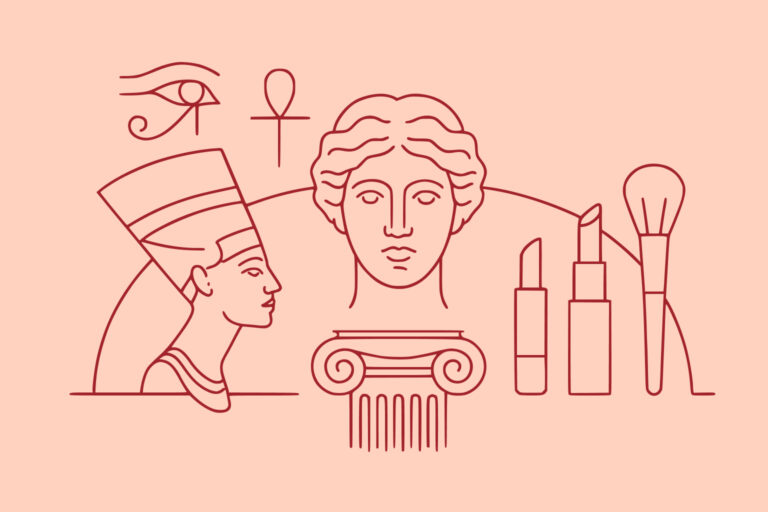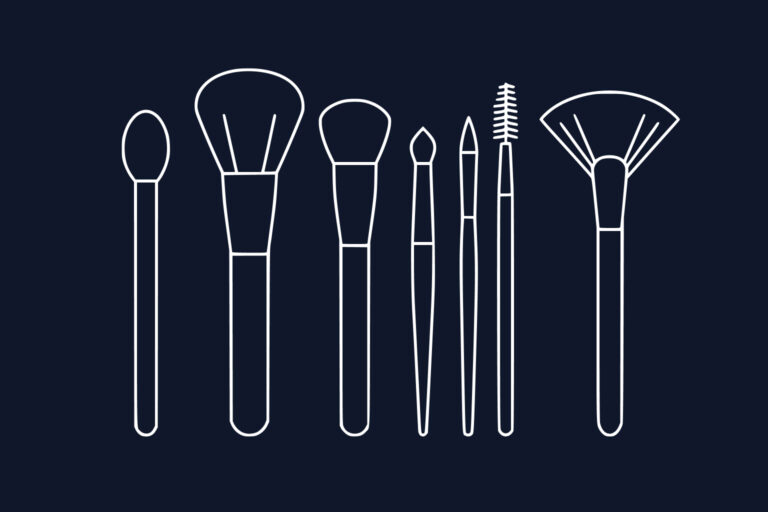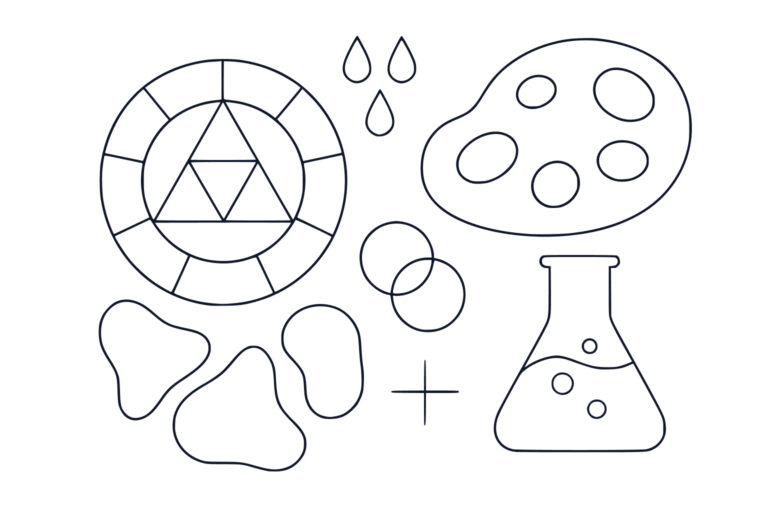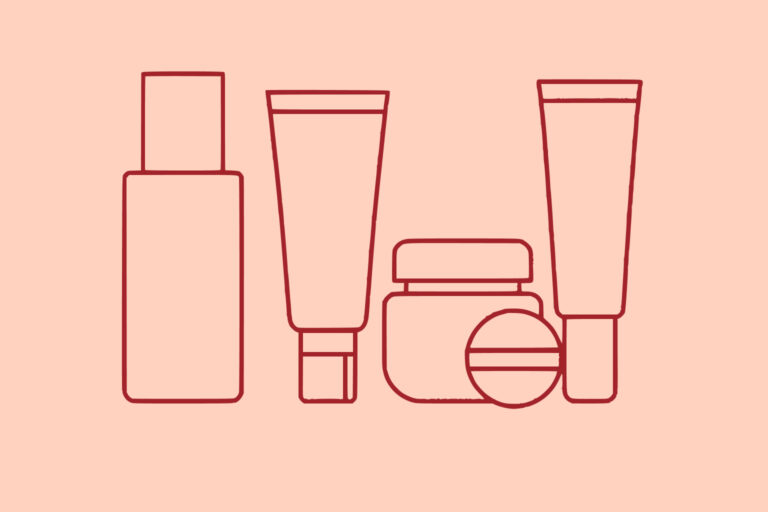The Art of Contouring Through the Ages: Sculpting Beauty Across Centuries
Published by Professional Makeup Artist London
Long before Instagram influencers popularised dramatic contouring techniques, humans have been using light and shadow to enhance and reshape their facial features. The art of contouring—using darker and lighter shades to create the illusion of different bone structure—has ancient roots that span cultures and centuries. From the theatrical traditions of ancient Greece to the Hollywood glamour of the 1930s and today’s social media-driven trends, contouring represents one of makeup’s most transformative and enduring techniques. This journey through contouring’s evolution reveals how the fundamental principles of light, shadow, and facial anatomy have remained constant whilst application methods and cultural ideals have dramatically evolved.
Ancient Foundations: The Birth of Facial Sculpting
The earliest forms of contouring can be traced back to ancient theatrical traditions, where performers needed to make their facial expressions visible to large audiences in outdoor amphitheatres. These practical needs led to the development of techniques that would later influence beauty practices across cultures and centuries.
Ancient Greek theatre established many of the fundamental principles of facial sculpting that remain relevant today. Greek actors used white lead and chalk to highlight prominent features like the forehead, nose bridge, and cheekbones, whilst employing darker pigments made from soot, charcoal, and various minerals to create shadows in the hollows of the cheeks, temples, and jawline. These techniques allowed facial expressions to be clearly visible even from the furthest seats in massive amphitheatres.
The Greeks understood that light naturally hits the highest points of the face whilst shadows naturally fall in recessed areas. By exaggerating these natural patterns with makeup, they could create more dramatic and visible facial structure. This understanding of how light interacts with facial anatomy became the foundation for all future contouring techniques.
Ancient Egyptian makeup practices also incorporated elements of facial sculpting, though their approach was more integrated into daily beauty routines rather than purely theatrical. Egyptian men and women used kohl not only to line their eyes but also to create subtle shadows that enhanced their facial structure. They understood how strategic placement of dark and light colours could make features appear more prominent or refined.
Roman theatrical traditions built upon Greek innovations, developing more sophisticated techniques for facial transformation. Roman actors created elaborate character makeup that could completely alter their appearance, using principles of light and shadow that would later influence Renaissance art and beauty practices.
These ancient techniques laid the groundwork for understanding how colour theory and light placement could be used to enhance natural features and create desired aesthetic effects.
Renaissance Artistry: Painting the Perfect Face
The Renaissance period brought a sophisticated understanding of art, anatomy, and beauty that revolutionised facial sculpting techniques. Tudor and Renaissance beauty practices incorporated artistic principles that treated the face as a canvas to be perfected through careful application of light and shadow.
Renaissance artists’ understanding of chiaroscuro—the dramatic interplay of light and dark—directly influenced makeup techniques of the period. Court painters like Hans Holbein and other portraitists documented the elaborate makeup styles of the era, showing how women used cosmetics to create idealised facial proportions that matched artistic representations of beauty.
The Renaissance ideal of beauty emphasised specific facial proportions that were considered mathematically perfect. Women would use makeup to create the illusion of these ideal proportions, employing techniques that prefigure modern contouring. They would lighten their foreheads to create the appearance of greater height and intelligence, use subtle shading to refine their nose shape, and carefully place colour to enhance their cheekbones and jawline.
Venetian ceruse, the white lead-based foundation that was popular during this period, served not only as a base colour but also as a highlighting agent. Women would apply it more heavily to areas they wanted to emphasise, creating a primitive form of highlighting that enhanced their bone structure.
The Renaissance practice of completely redrawing facial features with makeup required sophisticated understanding of facial anatomy and proportion. Women would cover their natural features with foundation and then recreate them in more idealised forms, using principles of light and shadow that demonstrate advanced contouring knowledge.
Court makeup artists of the Renaissance period were among the first professional practitioners of facial sculpting, developing techniques that would influence beauty practices for centuries to come. Their work established contouring as both an art form and a practical beauty technique.
18th Century Elegance: Powder and Patches
The 18th century brought new sophistication to facial sculpting through the elaborate use of powder, rouge, and beauty patches. This period saw the development of techniques that used colour and placement to create dramatic facial enhancement whilst maintaining the artificial aesthetic that defined the era.
The heavy use of white powder during the 18th century created a blank canvas that allowed for dramatic sculpting with rouge and other colour cosmetics. Women would apply rouge not only to their cheeks but also strategically to their temples, chin, and even their nose to create the illusion of different facial structure.
Beauty patches—small pieces of fabric cut into various shapes and applied to the face—served as an early form of contouring accent. These patches were placed strategically to draw attention to attractive features or create the illusion of different facial proportions. A patch placed near the mouth could make lips appear fuller, whilst one positioned on the cheekbone could enhance facial structure.
The 18th century also saw the development of more sophisticated rouge application techniques that went beyond simple cheek colouring. Women learned to use rouge to sculpt their faces, applying it in specific patterns that enhanced their bone structure and created the illusion of different facial shapes.
French court makeup artists of this period were particularly skilled in facial sculpting techniques, developing methods that could dramatically transform appearance whilst maintaining the artificial aesthetic that was fashionable at the time. Their techniques influenced beauty practices throughout Europe and established France as a centre of cosmetic innovation.
The elaborate makeup styles of the 18th century required considerable skill and time to execute properly, leading to the development of professional makeup application services and the establishment of beauty as a recognised art form.
Victorian Subtlety: The Art of Invisible Enhancement
The Victorian era’s emphasis on natural beauty led to the development of extremely subtle contouring techniques that enhanced facial features whilst maintaining the illusion of completely natural appearance. This period saw the refinement of facial sculpting into an almost invisible art form.
Victorian women mastered the art of using light and shadow so subtly that their enhancement appeared to be natural bone structure rather than applied makeup. They developed techniques for creating gentle shadows and highlights that enhanced their features without obvious artifice.
The Victorian approach to facial sculpting relied heavily on careful skin preparation and the strategic use of very light applications of colour. Women would use rice powder to create subtle highlighting effects and employ barely perceptible amounts of rouge to enhance their natural facial structure.
Pinching and other physical techniques were used to create temporary colour and definition that appeared completely natural. Victorian women understood how to manipulate their natural colouring to enhance their bone structure without using obvious cosmetics.
The development of photography during the Victorian era influenced contouring techniques, as women learned how their faces appeared in photographs and adjusted their makeup accordingly. This led to more sophisticated understanding of how light and shadow translated to different media.
Victorian contouring techniques required exceptional skill and restraint, as any obvious enhancement would have been socially unacceptable. This period established the principle that the best makeup appears to be no makeup at all, a concept that continues to influence contemporary beauty practices.
Early 20th Century: Theatre and Film Revolution
The early 20th century brought revolutionary changes to contouring through the influence of theatre and the emerging film industry. These new media required makeup techniques that could withstand close scrutiny and harsh lighting, leading to significant innovations in facial sculpting.
Stage makeup artists developed increasingly sophisticated contouring techniques to ensure that performers’ features remained visible under bright theatre lights. These techniques used dramatic contrasts of light and dark to create facial structure that could be seen clearly from the back of large theatres.
The emergence of cinema created new challenges and opportunities for contouring. Early film makeup artists had to develop techniques that worked under the intense lighting required for filming whilst creating effects that appeared natural on camera. This led to innovations in product formulation and application techniques.
Max Factor, one of the pioneers of film makeup, developed new products and techniques specifically for cinema that revolutionised contouring. His innovations included greasepaint formulations that allowed for more precise blending and longer-wearing effects that could withstand the demands of film production.
The influence of film stars on beauty trends brought theatrical contouring techniques into mainstream beauty culture. Women began adopting modified versions of stage and screen makeup techniques for their daily beauty routines, leading to more widespread acceptance of obvious makeup use.
The development of colour film in the 1930s required further refinement of contouring techniques, as makeup artists had to consider how their work would appear in full colour rather than black and white. This led to more sophisticated understanding of colour theory in facial sculpting.
Hollywood Glamour: The Golden Age of Contouring
The 1930s and 1940s represented the golden age of Hollywood glamour, when contouring reached new heights of sophistication and artistry. This period established many of the techniques and aesthetic principles that continue to influence modern makeup artistry.
Hollywood makeup artists of this era were true innovators who developed contouring techniques that could create dramatic transformation whilst appearing natural on screen. They understood how to use light and shadow to completely reshape facial features, creating the iconic looks that defined Hollywood glamour.
Stars like Greta Garbo, Marlene Dietrich, and Joan Crawford became famous not only for their acting but also for their distinctive makeup looks that showcased advanced contouring techniques. These looks were created by skilled makeup artists who understood how to enhance each star’s unique features whilst creating a cohesive aesthetic that defined their screen persona.
The development of new makeup products during this period, including more sophisticated foundations, powders, and colour cosmetics, allowed for more precise and long-lasting contouring effects. These innovations made it possible to create the flawless, sculpted looks that defined Hollywood beauty.
Lighting techniques in film production also influenced contouring methods, as makeup artists learned to work with cinematographers to create looks that would appear perfect under specific lighting conditions. This collaboration between makeup and lighting professionals led to more sophisticated understanding of how contouring interacts with different types of illumination.
The influence of Hollywood glamour on mainstream beauty culture brought contouring techniques to a broader audience, though most women adopted simplified versions of the elaborate techniques used in film production.
Mid-Century Evolution: Television and Changing Ideals
The 1950s and 1960s brought new challenges and opportunities for contouring through the emergence of television and changing beauty ideals. This period saw the adaptation of existing techniques to new media whilst developing approaches that suited evolving aesthetic preferences.
Television makeup required different techniques than film, as the medium’s lower resolution and different lighting conditions demanded adjustments to traditional contouring methods. Makeup artists had to develop techniques that would appear natural on television whilst still providing the enhancement that performers required.
The 1950s emphasis on feminine perfection led to refined contouring techniques that enhanced natural beauty whilst maintaining an appearance of effortless elegance. This period saw the development of more subtle approaches to facial sculpting that complemented the era’s preference for polished, sophisticated beauty.
The 1960s brought dramatic changes to beauty ideals, with the emergence of mod fashion and youth culture leading to new approaches to contouring. The period’s emphasis on bold, graphic makeup styles influenced facial sculpting techniques, leading to more experimental and artistic approaches.
The development of new cosmetic products during this period, including improved foundations and colour cosmetics, made contouring more accessible to average consumers. This democratisation of advanced makeup techniques led to broader adoption of facial sculpting in everyday beauty routines.
Fashion photography’s growing influence on beauty culture also affected contouring techniques, as makeup artists learned to create looks that would photograph well under various lighting conditions and for different types of publications.
The 1970s and 1980s: Disco Glamour and Power Dressing
The 1970s and 1980s brought bold new approaches to contouring that reflected the era’s dramatic fashion and cultural changes. This period saw the development of more obvious and theatrical facial sculpting techniques that complemented the decade’s emphasis on glamour and self-expression.
Disco culture of the 1970s embraced dramatic makeup that included bold contouring techniques designed to look striking under dance floor lighting. These techniques used strong contrasts and metallic highlights to create facial structure that would be visible and attractive in nightclub environments.
The 1980s power dressing movement influenced contouring techniques, with women adopting more dramatic facial sculpting that complemented the era’s bold fashion choices. This period saw the development of techniques that created strong, defined facial structure that projected confidence and authority.
The emergence of music videos and MTV culture brought new visibility to dramatic makeup techniques, including advanced contouring that could withstand the scrutiny of close-up camera work and dramatic lighting effects.
Advances in cosmetic technology during this period, including the development of new pigments and formulations, allowed for more dramatic and long-lasting contouring effects. These innovations made it possible to create the bold, sculpted looks that defined 1980s beauty.
The influence of drag culture on mainstream beauty during this period also affected contouring techniques, as drag artists’ advanced facial sculpting methods began to influence conventional makeup artistry.
The Digital Age: Social Media and Modern Contouring
The 21st century has brought unprecedented changes to contouring through the influence of digital media, social networking, and new cosmetic technologies. This period has seen the democratisation of advanced makeup techniques and the development of new approaches to facial sculpting.
The emergence of high-definition television and digital photography required makeup artists to develop new contouring techniques that would appear flawless under intense scrutiny. These demands led to innovations in product formulation and application methods that created more precise and natural-looking results.
Social media platforms, particularly Instagram and YouTube, have revolutionised how contouring techniques are shared and learned. Makeup artists and enthusiasts can now share detailed tutorials and techniques with global audiences, leading to rapid innovation and evolution in facial sculpting methods.
The influence of reality television and celebrity culture has brought dramatic contouring techniques into mainstream beauty culture, with many women adopting elaborate facial sculpting routines for their daily makeup looks.
The development of new cosmetic products specifically designed for contouring, including cream and powder formulations in a wide range of shades, has made advanced facial sculpting more accessible to average consumers.
Modern understanding of facial anatomy and lighting, combined with advances in cosmetic chemistry, has led to more sophisticated and effective contouring techniques that can create dramatic transformation whilst maintaining natural appearance.
Contemporary contouring benefits from understanding both historical techniques and modern innovations, combining traditional artistry with cutting-edge products and methods. This synthesis creates opportunities for both subtle enhancement and dramatic transformation.
Cultural Variations and Global Influences
Contouring techniques have developed differently across various cultures, reflecting local beauty ideals, available materials, and cultural attitudes towards makeup and self-enhancement. Understanding these variations provides insight into how facial sculpting adapts to different aesthetic preferences and social contexts.
Asian beauty cultures have developed unique approaches to contouring that emphasise different facial features and proportions than Western techniques. These methods often focus on creating the illusion of larger eyes, higher nose bridges, and more defined jawlines whilst maintaining harmony with natural Asian facial structure.
African and African diaspora beauty traditions have contributed significantly to modern contouring techniques, particularly through the influence of drag culture and professional makeup artistry. These traditions emphasise techniques that work effectively with darker skin tones and different facial structures.
Middle Eastern and South Asian beauty cultures have long traditions of using kohl and other cosmetics for facial enhancement that prefigure modern contouring techniques. These practices demonstrate how different cultures have independently developed methods for using light and shadow to enhance facial features.
The globalisation of beauty culture through social media and international fashion has led to increased cross-cultural exchange of contouring techniques, creating new hybrid approaches that combine elements from different traditions.
Understanding cultural variations in contouring helps modern makeup artists work sensitively with clients from diverse backgrounds whilst appreciating the rich global heritage of facial sculpting techniques.
The Science Behind Contouring
Modern contouring is based on scientific understanding of how light interacts with facial structure and how the human eye perceives depth and dimension. This scientific foundation helps explain why certain techniques are effective and how they can be optimised for different faces and lighting conditions.
The principles of light and shadow that govern effective contouring are based on how natural light falls on the human face. Light naturally hits the highest points of facial structure—the forehead, nose bridge, cheekbones, and chin—whilst shadows naturally fall in recessed areas like the temples, under the cheekbones, and along the jawline.
Understanding facial anatomy is crucial for effective contouring, as the technique works by enhancing or minimising the appearance of existing bone structure. Knowledge of where bones naturally create highlights and shadows allows makeup artists to place products strategically for maximum effect.
Colour theory plays an important role in contouring, as different undertones and intensities of colour create different visual effects. Understanding how warm and cool tones interact with different skin colours helps create more natural and effective contouring results.
The psychology of perception also influences how contouring is perceived, as the human brain interprets certain patterns of light and shadow as indicating specific facial structures. Effective contouring works with these perceptual tendencies to create desired visual effects.
Modern research into facial attractiveness and proportion has informed contemporary contouring techniques, providing scientific basis for methods that enhance features according to established principles of facial beauty.
Tools and Techniques Through the Ages
The evolution of contouring tools and application techniques reflects broader changes in cosmetic technology and understanding of makeup artistry. From primitive brushes and fingers to modern precision tools, the implements used for facial sculpting have dramatically influenced the results that can be achieved.
Ancient contouring relied on basic tools like fingers, primitive brushes made from animal hair, and simple sponges or cloths for blending. Despite these limitations, skilled practitioners could achieve sophisticated results through careful technique and understanding of facial structure.
The Renaissance period brought more sophisticated tools, including finer brushes and more precise application implements that allowed for greater control and more detailed work. These improvements enabled the elaborate facial sculpting that characterised the period’s beauty practices.
The 18th and 19th centuries saw continued refinement of tools and techniques, with the development of specialised brushes and application methods that allowed for more subtle and precise effects.
The 20th century brought revolutionary changes in tools and techniques through the influence of professional makeup artistry in theatre and film. Professional makeup artists developed specialised tools and methods that dramatically improved the precision and effectiveness of contouring.
Modern contouring benefits from advanced brush technology, precision application tools, and sophisticated blending implements that allow for professional-quality results. Understanding how to select and use appropriate makeup brushes and tools is essential for effective facial sculpting.
The development of new application techniques, including methods for blending, layering, and setting contour products, has made it possible to achieve more natural and long-lasting results than ever before.
Modern Innovations and Future Trends
Contemporary contouring continues to evolve through new product innovations, application techniques, and understanding of facial enhancement. Modern developments in cosmetic chemistry and makeup artistry are creating new possibilities for facial sculpting that were unimaginable in previous eras.
The development of new product formulations, including cream-to-powder hybrids, long-wearing formulas, and products specifically designed for different skin types, has made contouring more accessible and effective for a broader range of users.
Advances in colour matching and customisation allow for more precise selection of contour shades that work harmoniously with individual skin tones and undertones. This personalisation creates more natural and effective results than generic shade selections.
New application techniques, including methods for seamless blending, strategic layering, and setting products for longevity, continue to improve the quality and durability of contouring results.
The influence of digital technology, including apps that can simulate contouring effects and virtual reality training for makeup artists, is changing how facial sculpting techniques are learned and practiced.
Sustainable and clean beauty movements are influencing contouring product development, leading to formulations with natural ingredients and environmentally responsible packaging that don’t compromise on performance.
Future trends in contouring may include smart cosmetics that adapt to lighting conditions, biotechnology-derived ingredients that provide superior performance, and new application methods that could revolutionise how facial sculpting is approached.
Conclusion
The art of contouring represents one of makeup’s most enduring and transformative techniques, with roots that stretch back to ancient theatrical traditions and branches that continue to grow through modern innovation. From the dramatic facial sculpting of Greek theatre to today’s Instagram-worthy transformations, the fundamental principles of using light and shadow to enhance facial structure have remained constant whilst application methods and cultural ideals have evolved dramatically.
Understanding contouring’s rich history enriches our appreciation of this sophisticated makeup technique and helps us recognise the cultural forces that continue to shape beauty standards and practices. The journey from ancient pigments to modern formulations shows how human creativity and the desire for beauty have driven continuous innovation in cosmetic artistry.
As we look towards the future, contouring will undoubtedly continue to evolve, embracing new technologies, sustainable practices, and diverse beauty ideals. The lessons of history remind us that while tools and techniques may change, the fundamental human desire to enhance and transform our appearance through the artful use of light and shadow remains a constant thread connecting past, present, and future.
Whether exploring the broader history of cosmetics or mastering contemporary application techniques, understanding contouring’s evolution provides valuable context for appreciating this most sculptural of makeup arts. From ancient amphitheatres to modern social media, the power of strategic light and shadow to transform and enhance continues to captivate and inspire.




